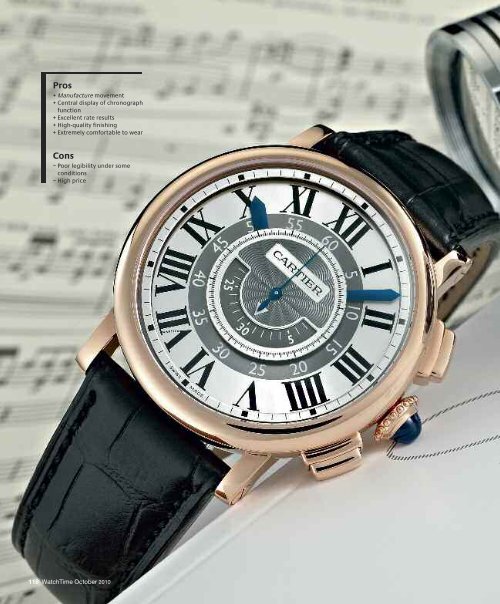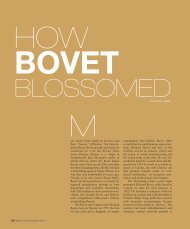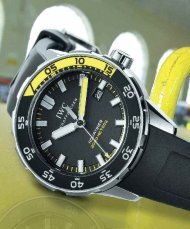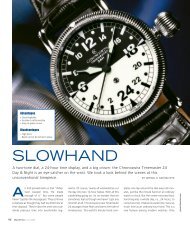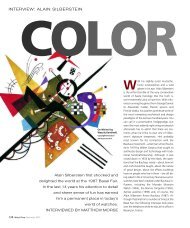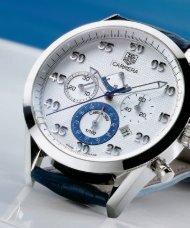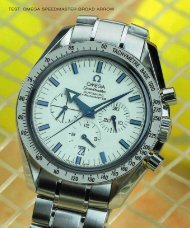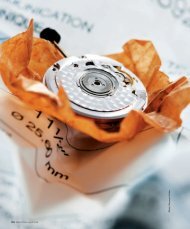close up cartier rotonde de cartier central chronograph
close up cartier rotonde de cartier central chronograph
close up cartier rotonde de cartier central chronograph
You also want an ePaper? Increase the reach of your titles
YUMPU automatically turns print PDFs into web optimized ePapers that Google loves.
Pros+ Manufacture movement+ Central display of <strong>chronograph</strong>function+ Excellent rate results+ High-quality finishing+ Extremely comfortable to wearCons– Poor legibility un<strong>de</strong>r someconditions– High price118 WatchTime October 2010
BY GERHARD SEELENCenterPHOTOS BY ZUCKERFABRIK FOTODESIGNStageWe shine a spotlight onCartier’s Roton<strong>de</strong> <strong>de</strong> CartierCentral Chronograph, whichtallies lapsed seconds in a raised<strong>central</strong> display on the dial, andits in-house Caliber 9907 MC.
CLOSE-UPCartier Roton<strong>de</strong> <strong>de</strong> Cartier Central ChronographSPECSCARTIER ROTONDE DE CARTIERCENTRAL CHRONOGRAPHManufacturer: Manufacture Cartier,Ch. <strong>de</strong>s Alisiers 10, CH-2300, La Chaux<strong>de</strong>-Fonds,SwitzerlandReference Number: W1555951Functions: Hour, minute, <strong>chronograph</strong>with <strong>central</strong> seconds and minutesMovement: Cartier 9907 MC, manualwind;28,800 vph; 35 jewels; Incablocshock absorption; Glucydur balance; flatNivarox hairspring; 51-hour power reserve;regulation via C-shaped regulator;column-wheel <strong>chronograph</strong> with verticalco<strong>up</strong>ling system; diameter = 25.6 mm;height = 7.10 mm; <strong>de</strong>corated with perlage,côtes <strong>de</strong> Genève, beveled edges andpolished screwsCase: Rose gold, sapphire crystals frontand back, water-resistant to 30 metersStrap and clasp: Alligator leather withrose-gold folding claspDimensions: Diameter = 42 mm, height =14.50 mm, weight = 143.0 gPrice: $35,400 ($37,900 in white gold)Only the tips of the hour andminute hands extend beyond theraised <strong>central</strong> <strong>chronograph</strong> dial.The <strong>chronograph</strong> seconds handis very thin.Cartier’s Roton<strong>de</strong> <strong>de</strong> Cartier CentralChronograph is aimed squarely at itswell-known competitors in the market ofluxury <strong>chronograph</strong>s with in-housemovements — a gro<strong>up</strong> that inclu<strong>de</strong>s theRolex Daytona, Au<strong>de</strong>mars Piguet JulesAu<strong>de</strong>mars, Breguet Marine, BreitlingChronograph B01, Jaeger-LeCoultreDuomètre and Patek Philippe Nautilus.With such impressive competition, Cartierset out to build a <strong>chronograph</strong> dramaticallydifferent from the rest in its class,and came <strong>up</strong> with a watch that does notcount elapsed minutes on a small subdiallike other <strong>chronograph</strong>s, but on a raiseddisplay in the center of the dial.This innovative two-part display provi<strong>de</strong>sbetter legibility of the elapsed timethan do most other <strong>chronograph</strong>s, whoseoverlapping hands can prevent a clearreading. Cartier began <strong>de</strong>veloping this<strong>chronograph</strong> in 2006 and introduced itlast year at the Salon International <strong>de</strong> laHaute Horlogerie in Geneva. The movement,Caliber 9907 MC, was <strong>de</strong>velopedand is manufactured in Cartier’s factoryin La-Chaux-<strong>de</strong>-Fonds, Switzerland (the“MC” in the caliber name stands for“Manufacture Cartier”).The dial of the Roton<strong>de</strong> <strong>de</strong> Cartier hastwo levels. The lower one has wi<strong>de</strong>, bluedsteelhands (though only the ends are visible)that show the current hour andminute. The higher one, in the center ofthe dial, is reserved for the <strong>chronograph</strong>.Pressing the start pusher at the 2o’clock position sets the s<strong>up</strong>er-slim chrono120 WatchTime October 2010
THE WATCH’SINNOVATIVE, TWO-LEVEL DISPLAYPROVIDES BETTERLEGIBILITY OF THEELAPSED TIME THANDO MOST OTHERCHRONOGRAPHS.12 31. The Cartier logo appears prominentlybelow the “XII” and 60-minute marker at12 o’clock, and more discreetly in the “V”of the Roman numeral VII at 7 o’clock.2. The levers for the start/stop and resetpushers have an unusual “L” shape.3. A wi<strong>de</strong>, 180° viewing window with astationary arrow pointer ensures easyreading of the elapsed minutes.seconds hand, mounted in the center of thedial, in motion. Elapsed minutes are registeredon the display below it, which consistsof a semicircle-shaped aperture and,beneath it, a rotating disk. A small trianglepoints to the elapsed minutes. The <strong>chronograph</strong>display appears to float above thedial, held by a sapphire ring whose extremelydiscreet <strong>de</strong>sign (patent pending)contributes to the complexity of the watch.The movement, which is manuallywound, has a column-wheel <strong>chronograph</strong>and vertical co<strong>up</strong>ling. It also has a relativelysmall number of components: only272, <strong>up</strong> to 75 percent of which are producedin-house. According to Cartier,fewer parts means less maintenance and alonger life for the movement. The philosophyseems to be, “It can’t break if it’s notthere.” Caliber 9907 MC has a diameterof 25.6 mm and height of 7.10 mm.A VIEW THROUGH the crystal caseback,with its eight screws, reveals the movement’sfine <strong>de</strong>tails. Every visible componentis hand-finished and the anodizedbridges are <strong>de</strong>corated with côtes <strong>de</strong>Genève. All of the edges on the bridgesare beveled and the lower plate has a perlagefinish.The column wheel and various leversand springs are so highly polished thatyou can see your reflection in them. Anothernice <strong>de</strong>tail is along the movement’sedge, where the blued, stainless-steel regulatorpointer has been shaped into aCartier “C.”October 2010 WatchTime 121
CLOSE-UPCartier Roton<strong>de</strong> <strong>de</strong> Cartier Central ChronographAbove: The hand-sewn alligator strap and rosegoldfolding clasp make an elegant combination.Left: A look beneath the caseback reveals abeautifully <strong>de</strong>corated, hand-wound movementwith côtes <strong>de</strong> Genève, beveled edges and a blued,“C”-shaped regulator.THE COLUMNWHEEL AND SOMEOF THE LEVERS ANDSPRINGS ARE SOHIGHLY POLISHEDTHAT YOU CAN SEEYOUR REFLECTIONIN THEM.122 WatchTime October 2010
A si<strong>de</strong> view of theCentral Chronographshows the rectangularpushers and large,bea<strong>de</strong>d crown with sapphirecabochon. The alligatorstrap is securelyfastened to the case atthe screwed lugs.If one removes the threa<strong>de</strong>d caseback(or, better yet, lets a watchmaker do it)he sees a metal movement ring in additionto a lot of “nothing” in the area ofthe winding stem and pushers. A bitmore attention to <strong>de</strong>tail, and a few more<strong>de</strong>corative finishes, would have beennice here, but this is nitpicking — thethree bridles and their screws are nicelypolished.When we placed the Roton<strong>de</strong> <strong>de</strong>Cartier in the timing machine, it showeditself to be so well regulated that the rateonly fluctuated between +1 second perday (with the dial <strong>up</strong>) and -2 seconds perday (in the crown-<strong>up</strong> position). After 24hours, the watch was still running at -2seconds per day in the crown- <strong>up</strong> positionwhile the crown-down and dial-<strong>up</strong> positionseach showed an additional gain ofone second, for a rate of +2 seconds perday in these two positions.We also wore the watch for 10 daysto <strong>de</strong>termine whether there were anydiscrepancies from the machine’s results.The on-the-wrist period confirmedthe machine’s results: thewatch’s average error was only +1 secondper day.Because the watch must be wound (atleast every 51 hours), we became familiarwith another distinctive feature: thebea<strong>de</strong>d, 18k-rose-gold crown with a <strong>de</strong>epblue sapphire cabochon. While at first itmight look a little too feminine for amen’s watch, we soon realized it is theperfect size and extremely easy to operate.The two rectangular pushers forstarting, stopping and resetting the<strong>chronograph</strong> follow the lines of the lugsand have a nice action, although the startand stop functions work somewhat moresmoothly than the reset.The watch’s 143-gram, round, rosegoldcase is attached to a jet-black alligatorstrap, which — though quite stiff atfirst — gently hugs the wrist within a fewshort days. The folding clasp can be individuallyadjusted and contributes to theoverall wearing comfort.All in all, the Cartier Roton<strong>de</strong> <strong>de</strong>Cartier Central Chronograph is a rich additionto the world of luxury <strong>chronograph</strong>s,with ingenious <strong>de</strong>sign and stateof-the-arttechnology.October 2010 WatchTime 123


